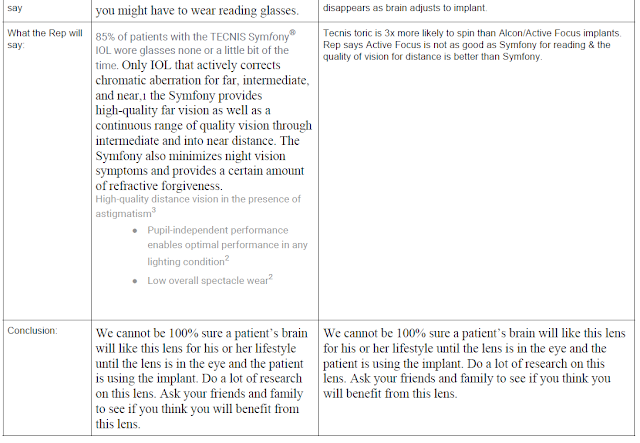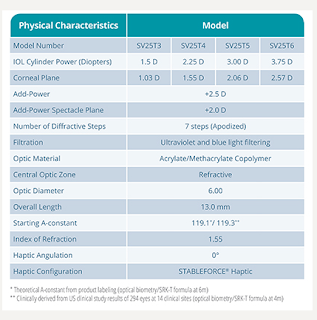Deciding which implant to have in your eye can be overwhelming! It is your eye and your vision and often a permanent decision. There are positive and negatives of each option and a great deal of information on each one. To make matters worse, many surgeons are paid by the company who makes these implants which I find disturbing! How can a surgeon present their surgical data and not be biased if they are getting a fat paycheck from the company. Ugh!
Still, we know these lens implants are better than what we have ever had in the history of the world. This is very exciting, but still leaves patients and surgeons trying to find the best implant for You and Your situation.
It is important for you to do your own research and do a bit of soul searching to see what are the most important things you like to do in life: do you like to do needle work, or fix watches, or play golf, or drive at night time; are you a pilot; would you be miserable if you had to live with noticing halos and glare? Are you super analytical or a type A or AAA personality?
Answering these questions and being open with your surgeon will help you and your surgeon be happy with the final result.
Even though we do live in the 21st Century and the technology to get patients back to the vision they had when they were younger is amazing and exciting, it is not 100% guarantee you will get the perfect result or be 100% happy even with 20/20 vision. The tear film, mild residual corneal astigmatism can affect the quality of your vision.
Below are some key factors that will help you decide which implant to choose.
I am not paid by any of these companies so feel I can be very objective about which implants are best. I have implanted every implant available in the Advanced Technology Implant category. Personally, I feel Symfony is currently the best implant in the world. Active Focus is exciting but time will tell if this implant gives better long term results than Symfony.
Either way, if I needed cataract surgery I would
choose Femtosecond Cataract Surgery with a Symfony implant knowing I might still need reading glasses to read and may have some halos and glare when looking at lights.
Sandra Lora Cremers, MD, FACS
Here is a Comparison of the Usual Implant options before Active Focus came out in 2017:
More information:
https://www.accessdata.fda.gov/cdrh_docs/pdf/P980040S065C.pdf

Contraindications There are no known conditions under which the TECNIS® Symfony Extended Range of Vision IOLs should not be used.
- Reduced incidence of halos and glare compared to a traditional multifocal IOL, with a 31 patient study reporting no spontaneous complaints of glare or halos at three months after implantation of the Tecnis Symfony®.1
- Improved contrast sensitivity and reduced chromatic aberration (an effect resulting from a failure of a lens to focus all colors to the same convergence point) compared to traditional multifocal IOLs.1
- Astigmatism correction can be included in the Tecnis Symfony® IOL, removing what was once a barrier to restoring a range of focus after cataract surgery.1
WARNING: The TECNIS Symfony® IOL may
cause a reduction in contrast sensitivity under certain conditions, compared to an aspheric monofocal IOL. The physician should carefully weigh the potential risks and benefits for each patient, and should fully inform the patient of the potential for reduced contrast sensitivity before implanting the lens in patients. Special consideration of potential visual problems should be made before implanting the lens in patients with macular disease, amblyopia, corneal irregularities, or other ocular disease which may cause present or future reduction in acuity or contrast sensitivity. Patients implanted with the lens should be informed to exercise special caution when driving at night or in poor visibility conditions.
This is ACTIVEFOCUS’s IOL insert information:






